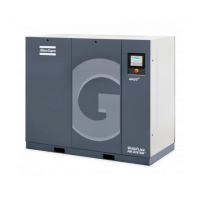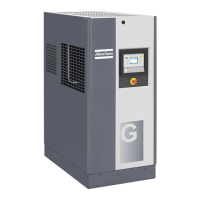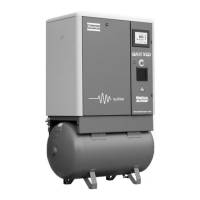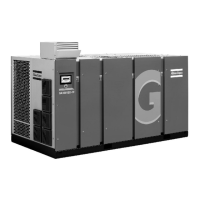Do you have a question about the Atlas Copco GA 75 VSD and is the answer not in the manual?
Explanation of warning symbols used in the manual for safety communication.
Guidelines and warnings for the safe installation of the compressor unit.
Critical safety measures to be followed during the compressor's operational phase.
Essential safety steps for performing maintenance and repair activities.
Overview of the GA 75/90 VSD compressors and their key features.
Diagram and explanation of the air circulation path within the compressor.
Description of the compressor's oil circulation, lubrication, and cooling system.
Explanation of the air and water cooling mechanisms used in the compressor.
Details on the electronic water drains for efficient condensate removal.
How the compressor output is regulated based on air consumption and speed.
Overview of the main electrical components and the control cabinet.
Schematics of the compressor's electrical circuits for reference and troubleshooting.
Explanation of the integrated air dryer's function, components, and circuits.
Introduction to the control system and its primary functions.
Identification and purpose of buttons, LEDs, and the display on the control panel.
Explanation of the primary functions associated with the regulator's keys.
How to navigate through menus and displays using the scroll keys.
Steps for safely stopping the compressor in an emergency situation.
Introduction to the menu-driven programs for managing compressor operation.
How to view compressor status and access functions from the main screen.
Detailed steps for navigating and accessing various menus within the regulator.
Method to quickly review the current operational status of the compressor.
How to view protection status, warnings, and reset system conditions.
Accessing data on energy savings compared to different control modes.
How to view measured operational data and input statuses.
Accessing accumulated data like running hours, starts, and volumes.
Procedure for performing a display test on the control panel.
Accessing settings for compressor/motor, parameters, and protections.
How to adjust operational settings like net pressure set-points.
Adjusting various operational parameters of the compressor.
Adjusting parameters for shutdown, warning levels, and service warnings.
How to adjust service intervals for planned maintenance tasks.
Setting up time-based start/stop commands and setpoint changes.
Adjusting settings like current time and compressor control modes.
Setting the compressor to operate locally, remotely, or via LAN.
Resetting service plans and checking previous service actions.
Accessing saved data such as last shut-down and emergency stop events.
Table of adjustable parameters for compressor/motor, protections, and service plans.
General view and designation of the oil/condensate separator components.
Procedures and guidelines for the installation of the OSD unit.
Guidelines for the safe operation and maintenance of the OSD unit.
Explanation of symbols related to OSD unit operation and maintenance.
Description of the energy recovery system and its main components.
Applications and types of energy recovery systems for compressor heat.
How the energy recovery system functions with compressor oil flow.
Procedures for maintaining compressor oil and components of the ER unit.
Data related to recoverable energy and water flow rates.
Technical drawings detailing the physical dimensions of the compressor.
Recommendations for compressor room layout, ventilation, and cooling.
Wiring diagrams and connection instructions for the compressor's electrical system.
Guidelines for water quality to prevent cooling system problems.
Explanation of safety and operational symbols related to installation.
Safety and preparation steps required before the first compressor start.
Step-by-step guide for the initial commissioning and start of the compressor.
Essential checks and preparations to be made before starting the compressor.
Detailed procedure for safely starting and running the compressor.
Guidelines for monitoring and safely operating the compressor.
How to read and interpret various messages and readings on the compressor display.
Procedures for stopping the compressor normally and in emergency situations.
Steps required to safely take the compressor out of service.
Schedule of routine checks and tasks for compressor upkeep and longevity.
Information on the compressor's drive motor lubrication and maintenance.
Details on recommended lubricants and oils for the compressor.
Procedure for changing the compressor's oil and oil filter.
Guidelines for environmentally friendly disposal of used parts and materials.
Procedures for storing the compressor when it is not in use.
Information on available service kits for component maintenance.
Procedure for inspecting, cleaning, and replacing the air filter element.
Instructions for cleaning the compressor coolers to maintain optimal efficiency.
How to operate, test, and safety precautions for the safety valve.
Troubleshooting guide for common compressor faults and their remedies.
Explanation of typical readings shown on the Elektronikon regulator display.
Guidelines for selecting appropriate cable sizes based on voltage and conditions.
Recommended settings for the fan motor circuit breaker.
Environmental conditions and operational limits for the compressor.
Technical specifications for GA 75 VSD and GA 90 VSD models.
Safety and operational guidelines for the use of the air receiver vessel.
Information on inspection requirements and relevant standards for the compressor.
Information on components subject to PED regulations and inspection requirements.
Explanation of warning symbols used in the manual for safety communication.
Guidelines and warnings for the safe installation of the compressor unit.
Critical safety measures to be followed during the compressor's operational phase.
Essential safety steps for performing maintenance and repair activities.
Overview of the GA 75/90 VSD compressors and their key features.
Diagram and explanation of the air circulation path within the compressor.
Description of the compressor's oil circulation, lubrication, and cooling system.
Explanation of the air and water cooling mechanisms used in the compressor.
Details on the electronic water drains for efficient condensate removal.
How the compressor output is regulated based on air consumption and speed.
Overview of the main electrical components and the control cabinet.
Schematics of the compressor's electrical circuits for reference and troubleshooting.
Explanation of the integrated air dryer's function, components, and circuits.
Introduction to the control system and its primary functions.
Identification and purpose of buttons, LEDs, and the display on the control panel.
Explanation of the primary functions associated with the regulator's keys.
How to navigate through menus and displays using the scroll keys.
Steps for safely stopping the compressor in an emergency situation.
Introduction to the menu-driven programs for managing compressor operation.
How to view compressor status and access functions from the main screen.
Detailed steps for navigating and accessing various menus within the regulator.
Method to quickly review the current operational status of the compressor.
How to view protection status, warnings, and reset system conditions.
Accessing data on energy savings compared to different control modes.
How to view measured operational data and input statuses.
Accessing accumulated data like running hours, starts, and volumes.
Procedure for performing a display test on the control panel.
Accessing settings for compressor/motor, parameters, and protections.
How to adjust operational settings like net pressure set-points.
Adjusting various operational parameters of the compressor.
Adjusting parameters for shutdown, warning levels, and service warnings.
How to adjust service intervals for planned maintenance tasks.
Setting up time-based start/stop commands and setpoint changes.
Adjusting settings like current time and compressor control modes.
Setting the compressor to operate locally, remotely, or via LAN.
Resetting service plans and checking previous service actions.
Accessing saved data such as last shut-down and emergency stop events.
Table of adjustable parameters for compressor/motor, protections, and service plans.
General view and designation of the oil/condensate separator components.
Procedures and guidelines for the installation of the OSD unit.
Guidelines for the safe operation and maintenance of the OSD unit.
Explanation of symbols related to OSD unit operation and maintenance.
Description of the energy recovery system and its main components.
Applications and types of energy recovery systems for compressor heat.
How the energy recovery system functions with compressor oil flow.
Procedures for maintaining compressor oil and components of the ER unit.
Data related to recoverable energy and water flow rates.
Technical drawings detailing the physical dimensions of the compressor.
Recommendations for compressor room layout, ventilation, and cooling.
Wiring diagrams and connection instructions for the compressor's electrical system.
Guidelines for water quality to prevent cooling system problems.
Explanation of safety and operational symbols related to installation.
Safety and preparation steps required before the first compressor start.
Step-by-step guide for the initial commissioning and start of the compressor.
Essential checks and preparations to be made before starting the compressor.
Detailed procedure for safely starting and running the compressor.
Guidelines for monitoring and safely operating the compressor.
How to read and interpret various messages and readings on the compressor display.
Procedures for stopping the compressor normally and in emergency situations.
Steps required to safely take the compressor out of service.
Schedule of routine checks and tasks for compressor upkeep and longevity.
Information on the compressor's drive motor lubrication and maintenance.
Details on recommended lubricants and oils for the compressor.
Procedure for changing the compressor's oil and oil filter.
Guidelines for environmentally friendly disposal of used parts and materials.
Procedures for storing the compressor when it is not in use.
Information on available service kits for component maintenance.
Procedure for inspecting, cleaning, and replacing the air filter element.
Instructions for cleaning the compressor coolers to maintain optimal efficiency.
How to operate, test, and safety precautions for the safety valve.
Troubleshooting guide for common compressor faults and their remedies.
Explanation of typical readings shown on the Elektronikon regulator display.
Guidelines for selecting appropriate cable sizes based on voltage and conditions.
Recommended settings for the fan motor circuit breaker.
Environmental conditions and operational limits for the compressor.
Technical specifications for GA 75 VSD and GA 90 VSD models.
Safety and operational guidelines for the use of the air receiver vessel.
Information on inspection requirements and relevant standards for the compressor.
Information on components subject to PED regulations and inspection requirements.
| Model | GA 75 VSD |
|---|---|
| Category | Air Compressor |
| Type | Rotary Screw Compressor |
| Power | 75 kW |
| Max Working Pressure | 13 bar |
| Cooling | Air-cooled |
| Voltage | 400 V |
| Drive | Variable Speed Drive (VSD) |











